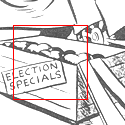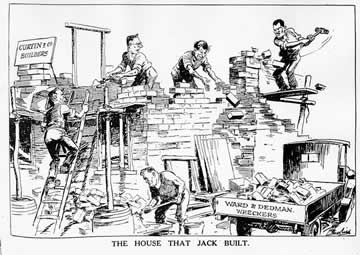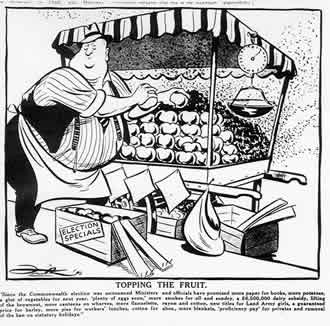

|
|
 |
||||||||
|
|
|||||||||
|
|
|||||||||
|
|
|||||||||
|
|
|||||||||
|
|
|||||||||
|
|
|||||||||
|
|
|||||||||
On assuming party leadership in 1935, Curtin used his talents and political savvy to unite the Australian Labor Party (ALP) into a cohesive, functioning unit that voters would see as a potential government. Since John Lang, then Premier of New South Wales, split the NSW Labor Party in 1931, the ALP had been weak and divided, with ongoing conflicts with the Lang Labor group. Curtin supported a proposal admitting Lang and his followers back into the official Labor Party and managed to bring all the disparate factions within Labor together to form an effective and unified party. By the time of the 1940 elections, even though problems with Lang's followers recurred from time to time, Labor was in a strong position, both within the party room and as an effective opposition party in parliament.
Government in Deadlock
After the 1940 election, parliament became almost unworkable for Prime Minister Menzies as both Houses were almost evenly divided. In the 74 member House of Representatives there were 36 members of the ALP-including four followers of Lang in New South Wales who had rejoined their ALP colleagues-and 36 Opposition members-including 23 from the United Australia Party (UAP) and 13 from the Country Party. The balance of power was held by two independents from Victoria, A W Coles and Alex Wilson. In the Senate there were 19 non-Labor members and 17 from the ALP.
Curtin himself came perilously close to losing the seat of Fremantle in this election because the heavy campaigning he did for Labor in the eastern states meant that he neglected his own constituency. Ultimately Curtin survived the election by 641 votes after gaining an unexpectedly high share of the preferences of an unendorsed Nationalist candidate.
The almost deadlocked situation that the Menzies Government found itself in led Menzies to renew offers to form a national government combining both Labor and non-Labor parties. Curtin held several meetings with Menzies to discuss the proposal. In the end, however, Curtin rejected the offer and instead suggested that an Advisory War Council be established. This Council, which first met in October 1940, provided Curtin with invaluable experience in wartime decision-making. The UAP-Country Party coalition became more unstable and in August 1941 Curtin wrote to Menzies: '[I]n view of your statement that you cannot secure...a workable Parliament you should return your Commission to the Governor-General and advise him of the purport of this communication.' (1) Curtin asserted that if he was given the same measure of cooperation in parliament as Labor had given Menzies, then Labor could form a stable government.
However, it was not until the UAP-Country Party coalition foundered in October 1941 that Curtin became prime minister. In the same difficult position as Menzies had found himself after the 1940 election - reliant on two Independents for power - Curtin's skill as a parliamentary tactician was put to the test. Historian Gavin Souter credits Curtin with being 'a patient and resourceful tactician' and perhaps 'the best manager of an evenly divided parliament since Alfred Deakin'. (2) All his skill was needed, for example, when dealing with the bills which gave the Commonwealth complete control over income taxation. On more than one occasion in 1942 and the first half of 1943 the Senate endeavoured to amend or even reject government legislation and it took compromise and skill to keep the government's program reasonably intact.
'The house that Jack built' cartoon by Ted Scorfield
published in the Bulletin on 18 November 1942.
Builders 'Curtin and Co.' work to build the house while members of
their own government, 'Ward and Dedman, Wreckers' knock it down
behind them.
1943 Election
Curtin's leadership during these difficult wartime years was acknowledged by Australian voters at the 1943 election which resulted in far and away the greatest victory ever recorded by the ALP at the federal level. It was also without precedent in that it provided the first and only instance when one party, the ALP, won every seat contested in either House in the prime minister's home state of Western Australia.
Such was Curtin's standing and integrity within the community that the 1943 election was fought on a campaign slogan of 'You can't have Curtin as a leader unless you vote for Labor'. 1943 was the first and only election that Curtin contested as prime minister and the dramatic landslide victory for him and his government provides a testament to the public's overwhelming confidence in their national leader and a vindication of his 20 months in office. Labor won 49 of the 74 seats and the Opposition parties 23, with Coles and Wilson retaining the other two seats. Labor was equally triumphant in the upper House - winning all the contested Senate seats in all six states. From 1 July 1944, when the newly elected senators took their seats, Labor had 22 of the 36 Senate members. In the interim Labor increased its Senate representation to 18 with the inclusion of the first woman - Senator Dorothy Tangney from Western Australia.
In his last election speech Curtin had specified three tasks for the incoming government: to 'direct the coming offensive against Japan', 'be responsible for Australia's part in the peace conference' and work 'for demobilization and post-war reconstruction'. In performing these tasks the Curtin Government from 1 July 1944 was the first Labor federal government to control both Houses of Parliament since the conscription split in 1916. The five and a half year period which followed when the ALP could implement its legislative program without disruption in either House of the Commonwealth Parliament was only paralleled in the past by the experience of the Fisher Labor Government 1910 to 1913 and the Fisher and Hughes governments from 1914 to 1916. Control of both Houses has not been seen in the period since 1949 until the Howard Liberal Government's election wins of 2004.
Topping the fruit. "Since the Commonwealth election was announced Ministers and officials have promised more paper for books, more potatoes, a glut of vegetables for next year, 'plenty of eggs soon', more smokes for all and sundry, a £6,500,000 dairy subsidy, lifting of the brownout, more canteens on wharves, more flanelette, rayon and cotton, new titles for Land Army girls, a guaranteed price for barley, more pies for workers' lunches, cotton for abos., more blankets, 'proficiency pay' for privates and removal of the ban on statutory holidays." Cartoon by John Frith published in the Bulletin on 14 July 1943.

